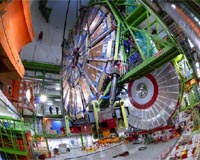 |
Washington DC (SPX) Jul 13, 2010 Physicists have long known that neutrinos are among the lightest and most evasive fundamental particles. Now a survey of the galaxies is helping to narrow down the neutrino mass even further. It seems that neutrinos are at best half as massive as previously estimated, according to an analysis appearing in the journal Physical Review Letters. The lower neutrino mass estimate is the result of a 3-dimensional survey of more than 700,000 galaxies called MegaZ DR7. Although neutrinos are very light and interact with matter very rarely, they are so numerous that they can have a significant effect on the evolution of the material distribution in the universe. The galactic distributions revealed in the MegaZ map appear consistent with a reduced upper limit of neutrino mass estimates. There are restrictions on the information the map can provide, in part because there are three varieties of neutrinos (electron, muon, and tau neutrinos), each of which likely have different masses. As a result, MegaZ can only estimate the sum of the three neutrino masses. The galactic distribution suggests that the combined mass the three neutrino varieties is less than 0.28 electron volts. Although the survey doesn't offer a lower limit of neutrino masses, it's clear from the detection of neutrinos coming from our sun, as well as from laboratory experiments, that neutrinos have at least some mass.
Share This Article With Planet Earth
Related Links American Physical Society Understanding Time and Space
 World's biggest atom smasher gains pace: CERN
World's biggest atom smasher gains pace: CERNGeneva (AFP) June 28, 2010 The world's biggest atom smasher is swiftly gaining pace as scientists seek to unravel the secrets of the universe, the European Organisation for Nuclear Research (CERN) said on Monday. The Large Hadron Collider has been setting records for the intensity of proton collisions since scientists started firing beams of the sub-atomic particles at unprecedented energy levels on March 30, CERN spo ... read more |
|
| The content herein, unless otherwise known to be public domain, are Copyright 1995-2010 - SpaceDaily. AFP and UPI Wire Stories are copyright Agence France-Presse and United Press International. ESA Portal Reports are copyright European Space Agency. All NASA sourced material is public domain. Additional copyrights may apply in whole or part to other bona fide parties. Advertising does not imply endorsement,agreement or approval of any opinions, statements or information provided by SpaceDaily on any Web page published or hosted by SpaceDaily. Privacy Statement |